More Junkmail from Bob!
Saturday, September 18, 2004Important Stuff
Geysirs, Clocks, and Satellites
Mount Hekla is a very active volcano in Iceland. Here's a picture of Iceland last January.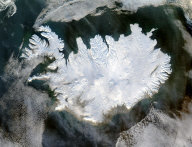
Mount Hekla erupted in 1970, 1980, 1981, 1991, and 2000. It also erupted in 1845 for about 7 months.
http://www.south.is/hekla.html
The Great Geyser (or Geysir), near Mount Hekla, erupted regularly, more or less, from the late 1300's until about 1916. It shot hot water 260 feet high. After some earthquakes in 2000, sometime around Mount Hekla's latest eruption, the Great Geyser resumed occasional eruptions. The Strokkur geyser is nearby and erupts every 10 minutes or so, shooting water about 115 feet high. Here's the Strokkur geyser about a year ago:

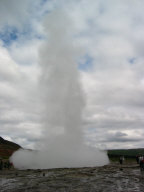
Robert Wilhelm Eberhard von Bunsen was born in Göttingen, Germany in 1811, obviously a direct result of the New Madrid Earthquake. He had a long name, so I'll call him Bob.
Bob went to Iceland on a geological trip sponsored by Denmark after the 1845 eruption of Mount Hekla. That eruption lasted seven months. Bob took a boat because he couldn't book a flight. While Bob was in Iceland he figured out how geysers work. He took some temperatures of the Great Geyser, sampled its water, and sampled water off boiled surface rocks.
He decided that the water was just ordinary water and not of volcanic origin. After taking temperatures inside the geyser tube, he figured out that the pressure differential of the moving water causes it to boil somewhere in the middle of the tube, launching the water out the top in a geyser. Then he went home to Germany and built an artificial geyser to prove his point. Bob's geyser model has been generally accepted ever since.
In about 1855, Bob invented a gas burner for chemistry work. He needed strong heat source with low luminescence. He achieved this by mixing air with gas before it got to the flame. Strangely, today this is called the Bunsen burner instead of the Bob burner. Bob did a lot of other chemistry and physics work. The burner was just a tool he needed, so he made it.
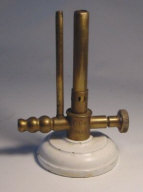
In 1860, Bob and his friend and colleague Gustav Kirchoff discovered a new metal: Cesium.
http://chem.ch.huji.ac.il/~eugeniik/history/bunsen.html
http://www.chemheritage.org/EducationalServices/chemach/ppt/bk.html
Cesium
There are only three metals that are liquid at room temperature: cesium, gallium and mercury. Cesium has 32 isotopes, more than any other element except possibly Francium. Cesium is worth about $30 per gram, two or three times more than gold. Cesium is used in electron tubes, photoelectric cells, and biodegradable drilling fluid. Cesium is also used as the "timekeeper" in atomic clocks.
http://pearl1.lanl.gov/periodic/elements/55.html
Here's an interesting periodic chart. You can click on any element and read about it:
http://pearl1.lanl.gov/periodic/default.htm
Atomic Clocks
The Cesium atomic clock works by detecting the resonant frequency of the Cesium 133 atom, which happens to be 9,192,631,770 hertz (cycles per second). How do we know that one second is exactly equal to 9,192,631,770 cesium cycles? I assumed it would be closer to 9,192,631,771 hz, or maybe 9,192,631,770.627 hz. Who figured out this coincidence?
It's not a coincidence. In 1967, the 13th General Conference on Weights and Measures changed the length of a second to be precisely 9,192,631,770 cesium cycles, rather than 1/86,400 of an earth day. This shouldn't matter much because most of us can't measure the length of an earth day any more accurately than .1 billionth of a second, about the length of a cesium cycle.
I was wondering. Suppose I head up to Bernic Lake, Manitoba and pick up some pollucite -- cesium ore. There's supposed to be about 300,000 tons of it there, containing 20% cesium. About two thirds of the world's known pollucite reserves are there.
http://www.gov.mb.ca/itm/mrd/busdev/industrial/tantalum.html
After I have my cesium ore and manage to refine, smelt, or otherwise purify it, how can I use the cesium to tell time? Simple. I hit the cesium with microwaves, and keep adjusting the frequency until I get the resonant frequency. I'll know I found it when I get the biggest reaction from the cesium atoms, that is, when the largest number of cesium atoms are in an excited quantum state.
When I have the microwave transmitter tuned to that frequency, I'll know it's at 9,192,631,770 hertz. From there I can calculate the length of a second very accurately, and build a clock. (I thought about preceding that last sentence with "Indeed it is trivial to show...", a phrase they put in math books to warn you that something really bad is coming.)
In 1937, Isidor Rabi, a physics professor at Columbia University, and his team developed the method of measuring frequency very accurately using molecular beams. A few years later in 1945 he suggested using this technique to build a clock. In 1951, the first atomic clock was completed. It was really a molecular clock because it used ammonia molecules instead of elemental atoms, but the principle is the same. The first cesium atomic clock was completed in 1955.
The cesium clocks, up until a few years ago, operated like this:
- Heat up some cesium until it vaporizes.
- Direct some gaseous cesium through a tube.
- Separate the low-energy atoms from the high-energy atoms using an electromagnet.
- Hit the stream of low-energy atoms with a microwave beam.
- Separate that beam into low-energy and high-energy atoms with an electromagnet.
- Direct the high-energy beam to a wire where the atoms ionize and can be counted with an electron multiplier or a really fast grad student.
- Adjust the frequency of the microwave beam in step 6 to maximize the high-frequency atoms counted in step 6.
- Divide the microwave frequency by 9,192,631,770 and start ticking off seconds.
http://opdaf1.obspm.fr/www/horloge_cs.html
The clock in 1951 was accurate to around one second per year. This was a little better than measuring the earth's daily rotation, but not as good as measuring the earth's annual orbit around the sun.
In 1955 the first cesium atomic clock was built in Britain. In addition to cesium, it had more accurate frequency control and other advances "too numerous to mention." That means I don't know what else. This clock was accurate to one second in 300 years, better than any previous timekeeping.
The cesium clocks kept getting better, essentially on the same design. In 1993, the National Institute of Standards and Technology (the official timekeeper of the U.S.) got their 7th official cesium clock design. It was accurate to 1 second in 1.4 million years, or 2 nanoseconds per day -- 2 billionths of a second per day.
That seems unbelievable. Until you consider that 1066 MHz memory is commonplace now for personal computers. That memory can be accessed in 1 billionth of a second.
In 1995, the first atomic fountain clock was built at the BNM Paris Observatory. Here's how to build an atomic fountain cesium clock:
- Get some cesium gas and put it into a vacuum chamber.
- Point six lasers into the center of the chamber from the left,
right, front, back, top, and bottom. This gently pushes the cesium
atoms into a ball and cools them to within a few millionths of a degree
of absolute zero. This sounds like there must be some hocus-pocus
involved here, but it really works. The 1997 Nobel Physics Prize
winners had something to do with that.
- Use the laser pointers to toss the ball up slowly, and then turn off the lasers.
- The cesium "ball" passes through a microwave chamber on the way up, and then again on the way down. It all takes about a second.
- Shoot the cesium ball with another laser, called a probe laser, and see how much light is emitted by the cesium. The more light there is, the more cesium atoms had their state altered.
- Adjust the microwave frequency to maximize the fluorescence of the cesium, repeating the process each adjustment. That frequency at the maximized fluorescence is 9,192,631,770 cycles per second.
- Divide the microwave frequency by 9,192,631,770 and start ticking off seconds.
http://www.boulder.nist.gov/timefreq/cesium/fountain.htm
The current generation of cesium clocks operate to an accuracy of 1 second in 30 million years, or an error of less than 0.1 nanoseconds per day.
Here is some more cesium clock information:
http://tycho.usno.navy.mil/cesium.html
http://www.boulder.nist.gov/timefreq/cesium/atomichistory.htm
There are a couple of projects underway or on hold to put atomic clocks on the International Space Station, a cesium clock and a rubidium clock. These will be more accurate than those on earth because they don't have to contend with as much gravity.
The cesium clock project (PARCS) was supposed to launch in 2003, but it's been delayed until about 2008 because the Japanese Experimental Module (JEM), in which it will be housed, was delayed when the space shuttles were grounded. It will take 3 shuttle missions to transport the JEM to the space station.
http://funphysics.jpl.nasa.gov/technical/lcap/parcs.html
The RACE clock will be based on rubidium instead of cesium. It should be accurate to within about 1 second in 3 billion years.
http://funphysics.jpl.nasa.gov/technical/lcap/race.html
Why on earth (or above earth) would we ever need to keep time that accurately? There are lots of reasons. With very accurate time, you can measure frequencies very accurately. For example, the doppler radar gun used to give me a speeding ticket measures the frequency of the radar signal that bounces off my car, and calculates my speed. Using similar techniques you can find interesting things such as speed and distance about objects in space. There are many other applications in physics and astronomy for highly accurate timekeeping.
GPS Clocks
A common application for very accurate clocks is in GPS satellites. If you have a GPS receiver, it tells you where you are. Or at least it tells you where it is. It does this by receiving time data from the GPS satellites. The GPS receiver knows where the satellites are, so by calculating the difference in the times it receives, it can triangulate its position.
In order for the GPS position to be accurately calculated, the clocks in the GPS satellites have to be synchronized and accurate.
Consider that the GPS satellites are flying around the earth about 20,000 km high at about 14,000 km/hour. That's high, and that's fast. In order to use the satellites for positions accurate to within a few feet, the clocks have to be have an accuracy of 20-30 billionths of a second (20-30 nanoseconds). To achieve this, each GPS satellite has an atomic clock on board.
Back in the first half of the last century, a guy named Einstein came up with a couple of theories -- the Special Theory of Relativity, and the General Theory of Relativity. According to these theories, clocks on GPS satellites would run a little slower than clocks on earth. This is not because of a physical characteristic of clockworks. It's because time itself runs slower on the satellites relative to time on earth.
Calculations using the theory of Special Relativity say that time in the GPS satellites is about 7 nanoseconds per day faster because of their speed. Calculations using the theory of General Relativity say that time in the GPS satellites is about 45 nanoseconds per day slower because of less gravity at that altitude. Even though there is weightlessness in orbit, gravity at 20,000 km altitude is about 25% as strong as on the surface of the earth. If there were no gravity at 20,000 km, you wouldn't have to orbit the earth to stay there -- you would just hover.
If you add these together, you would expect the GPS clocks to run 38 nanoseconds per day slower because of Einstein and his theories. So how important could an error as tiny as 38 billionths of a second per day be? Pretty important. That would introduce a positional error in your GPS receiver of about 6 miles per day!
They weren't sure whether this error would really happen when they launched the first GPS satellite in 1977. After all, how can you expect time itself to speed up or slow down? The theory of General Relativity says most of this error is due to the warping of space-time by gravity. That seems counter-intuitive, if not flat crazy.
So they added a remote control function to the first GPS satellites that could configure the GPS atomic clocks to have fewer cesium cycles per second, enough to account for the difference between theoretical time on a GPS satellite and earth time. They started out using earth-sized seconds on the satellite. After 20 days, they could see that the GPS satellite clock was off by 38 nanoseconds per day. Once again, Einstein was proven correct. Maybe there really is something to that relativity stuff.
http://www.physicscentral.com/writers/writers-00-2.html
GPS Fun
Now you can use all this high-level physics, atomic clock technology, and other sophisticated magic with a GPS receiver that costs less than $100. You can go anywhere on earth and find your location with a GPS receiver small enough to hold in your hand or wear on your wrist.
You can track where you've been. You can track your speed. For example, I recently got a speeding ticket for going 87 mph in Wyoming. The speed limit was 75. But I was going between 83 and 84. I have the GPS data to prove it, and it is unquestionably more accurate than the speedometer in the highway patrol car. I already paid the ticket, since I was speeding, but I intend to do some letter writing. Those guys cheated me out of 3 or 4 miles per hour! Even so, it is probably a good thing that the highway patrolman, my parents, and my kids didn't see the maximum speed logged by the GPS.
It's fun to download a GPS track onto a computer to see where you've been hiking, biking, boating, or driving. You can get a lot of information such as average speed, moving average, track (including vertical profile), and the time when you were at any location along the track. If I were a criminal, a terrorist, or a Democrat, these GPS tracks could be useful things for the police to subpoena.
In fact, it's fairly common for police, divorce lawyers, and other surveillers to plant GPS receivers on cars to collect travel information on unsuspecting criminals, adulterers, and various and other nefarious types. Sometimes it's legal and sometimes it's not, depending on the judge.
A popular GPS pastime is geocaching. People plant "geocaches" at certain GPS coordinates, given in latitude and longitude. Other people use their GPS to discover the cache full of goodies. There are thousands of these around the country. You can get information on geocaching at
http://geocaching.com
You can search for nearby geocaches and see where they are on a map. Usually they contain interesting items of little value, but I planted my first geocache a couple of weeks ago along with 3 other planters, and left 10,000 cash in the cache.
Oh yeah. That was 10,000 Korean.
Chats
You can never be sure what kind of person you're talking to when you chat on the internet. The standard story is that someone who claims to be a young, attractive female is really a 50-year-old guy with a beer gut. Now it's even worse -- that person you're chatting with on the internet might not even be a person!You can use CAB, Chatting AIM Bot, free. It is a program that pretends to be a human while it chats with your family or friends. After about 10 minutes of conversation, it tells them that they've been speaking to a program instead of a person. I'd try it, but most people I know would consider it an improvement to chat with a bot instead of me.
CAB works with AOL Instant Messenger.
http://www.chattingaimbot.com
http://wired.com/news/culture/0,1284,64888,00.html
No-Fly Zone -- The U.S.?
Before the war in Iraq, a large part of that country was considered a no-fly zone where people were not allowed to fly airplanes. A few days ago, a guy from New York named Anthony introduced a bill in the U.S. House of Representatives that would make a large part of the U.S. a no-fly zone. The law applies only to private planes. I guess the politicians have forgotten that it was airliners that crashed into those buildings three years ago.According to the proposed law, no private aircraft would be allowed to fly into, out of, or over any part of New York, Los Angeles, Chicago, Houston, Philadelphia, Phoenix, San Diego, San Antonio, or Dallas. (For some reason they left out Boatman, OK.) Full security screening would be required on every flight of every aircraft in the United States, even single person planes operating out of cow pastures. Non-airline traffic would be prohibited from flying within 1500 feet of any structure or building. That is triple the current limit which applies to all airplanes but not helicopters. (Again, Anthony must have forgotten about the airliners that hit the buildings in his home state.)
The law requires pilots of all aircraft remain in radio contact with controllers at all time in every flight everywhere in the U.S. The law does not address the fact that not all airplanes have electrical systems, let alone radios. The law also does not address the fact that there are many places in the U.S. that air traffic controllers do not have radio coverage.
If you haven't figured it out yet, I think this law, this idea, and Anthony are really, really stupid. Small planes are nowhere near as effective a tool for blowing up things as automobiles. You hear about car bombs blowing up people all over the world, but when is the last time you heard of a small plane bomb? Small planes don't carry much weight, airplanes are harder to get and operate than cars, and it is much harder to time a bomb to blow up on target in an airplane than in a car.
Maybe Anthony should close down all the roads and seize all the cars in New York instead of worrying about airplanes. In addition to making the state more secure, he would eliminate hundreds of auto accident deaths each year.
Australia's DMCA
The United States and the Recording Industry are not happy with the Digital Millennium Copyright Act. It is too local. So the U.S. is pressuring Australia to adapt the law as part of a Free Trade Agreement.President George said, "We have clear, incontrovertible evidence that someone in Australia has illegally downloaded a U.S. song, flying in the face of UN resolution 3.141592654, clearly a crime against humility. I am willing to use all force necessary to eliminate this clear and present danger to the United States of America. We will shock and awe the people of Australia with American might and American resolve." Or maybe he didn't.
http://www.wired.com/news/business/0,1367,64898,00.html
Inducement
If Senators Orrin and Patrick have their way, it is going to get harder and harder to back up your computer, CDs, and videos. They want to make it illegal to produce or own hardware that is even capable of copying music or movies. You won't even have to copy anything to break this law -- you'll only have to own something that could be used to copy something that is copyrighted. I'm not sure whether this law applies to photocopiers.Why would Orrin and Patrick make a law like this that nobody but the music and movie people want? Cash. TV, music, and movie companies gave Orrin $168,928 and Patrick $232,050 since 1999. It's a democracy!
http://www.wired.com/news/politics/0,1283,64935,00.html
Serious Bank Fraud
China would like people to invest in China. People would hesitate to invest in China if the financial system looked corrupt. So when China found four people guilty of bank fraud, they were executed.http://money.cnn.com/2004/09/14/news/international/china_banks.reut
Hermann Goering
G.M. Gilbert was an American intelligence officer. He was also the prison psychologist during the Nuremberg trials after World War II, with unlimited free access to the top Nazi officers throughout the trial. He recorded his conversations in "The Nuremberg Diary," still in print today. You can get it at http://amazon.com and http://bn.com. I haven't read it, but I did order a copy. Here's a review:http://www.history-europe.com/Nuremberg_Diary_0306806614.html
Hermann Goering (or Göring, if you use that kind of alphabet) was commander of the German Air Force, the Luftwaffe, in World War II. He was number 2 Nazi, behind Hitler, for most of the war. Then Hitler fired him and had him arrested. After the war at the Nuremberg trials, Goering was found guilty of a lot of very bad things and was sentenced to hang. He committed suicide with a cyanide capsule a couple of hours before his execution time.
In The Nuremberg Diary, Gilbert recorded a conversation he had with Hermann Goering on Easter break, 1946:
Goering: Why, of course, the people don't want war. Why would some poor slob on a farm want to risk his life in a war when the best that he can get out of it is to come back to his farm in one piece?
Naturally, the common people don't want war; neither in Russia, nor in England, nor in America, nor for that matter in Germany. That is understood. But, after all, it is the leaders of the country who determine the policy and it is always a simple matter to drag the people along, whether it is a democracy, or a fascist dictatorship, or a parliament, or a communist dictatorship.
Gilbert: There is one difference. In a democracy the people have some say in the matter through their elected representatives, and in the United States only Congress can declare wars.
Goering: Voice or no voice, the people can always be brought to the bidding of the leaders. That is easy. All you have to do is tell them they are being attacked, and denounce the pacifists for lack of patriotism and exposing the country to danger. It works the same in any country.
If you want to read the original German, you can get it here:
http://www.amazon.de/exec/obidos/ASIN/3596218853
Terrorist Attack Narrowly Averted
A possible terrorist plot was foiled in Tampa, Florida last month when a 52-year-old woman was discovered attempting to smuggle a concealed bookmark onto an airliner. Kathryn, who claimed to be a tourist, was found with an 8.5-inch leather bookmark. She was handcuffed and led away to a police car. She was then placed in an airport holding cell where she could not endanger the other passengers. It was not reported whether she was allowed to read her book while she was inside the cell.Kathryn made the unlikely assertion that she had used the bookmark for years and had taken it with her on several flights since 9/11/2001. She claimed to be a special education teacher from Maryland vacationing in Florida. She further claimed to have a master's degree from Johns Hopkins University, although she did not have her diploma on her person at the time of her detention. Kathryn went on to say that she was a Sunday school teacher, a highly unusual position for a Muslim terrorist.
The 52-year-old terrorist suspect faces a $10,000 fine for transporting illegal weapons into an airport security area, and was charged with the possession of a concealed weapon.
http://www.sptimes.com/2004/09/17/Hillsborough/Tourist_s_crime_Totin.shtml
Quote of the Day
"These people weren't just terrorists -- they were criminals!"National Public Radio
Genesis
The Genesis spacecraft came back to earth after spending around two and a half years circling the sun, collecting solar particles dust. Unfortunately, the parachute didn't open.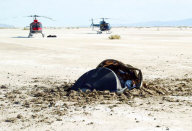
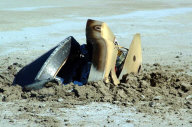
Some of the samples were contaminated, but NASA things they can still get some good data out of the mission.
http://www.nasa.gov/mission_pages/genesis/media/genesis-091604.html
Pictures of Today
Most of these NASA photos have detailed information in the comment section of the images. To see that, save them on your hard drive and look at the comments with a photo program, such as Photo Mud (http://xpda.com/photomud).The Space Shuttle on a 747:
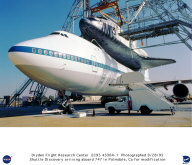
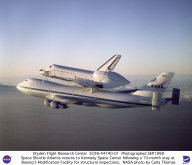
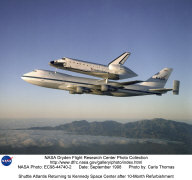
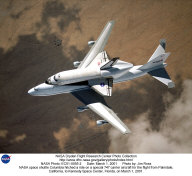
Space Shuttle Atlantis launch, December 2, 1988:
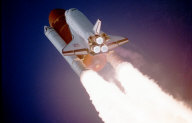
Space Shuttle Columbia launch, October 22, 1992:
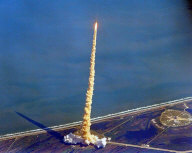
Apollo 17 launch, December 17, 1972:

Astronaut Harrison H. Schmitt working on the moon, Apollo 17:
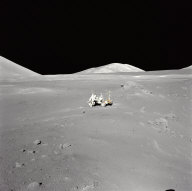
Apollo 16 splashdown, April 27, 1972:
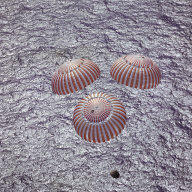
A 1957 test of Vanguard launch vehicle for U.S. International Geophysical Year program to place a satellite in Earth orbit to determine atmospheric density and conduct geodetic measurements. A malfunction in the first stage caused a loss of thrust after two seconds, and the vehicle was destroyed.
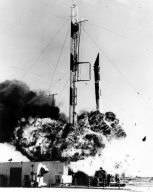
Apollo 11 splashdown:
The Wright Flyer, a twin-engine "pusher," December 17, 1903 [correction -- The Wright Flyer only has one engine, but two props. Oops.]:
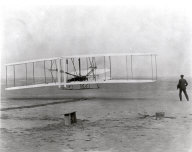
Three more twin engine "pushers":
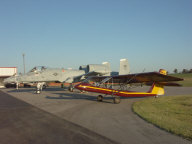
The Light Eagle and the Daedalus human powered aircraft. After its flight testing and NASA Dryden Flight Research Center, the Daedalus was flown from the Greek island of Crete to the island of Santorini, 199 km, in 3 hours and 54 minutes.
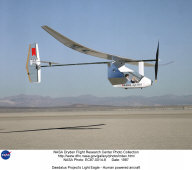
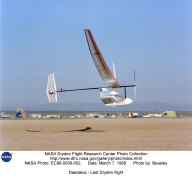
One of three X-15s on its launch platform, a B-52:
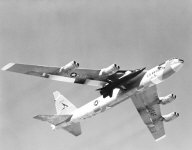
In 1962, pilot John McKay was injured in this emergency landing after an engine failure, but recovered enough to fly again.

The X-15 and its B-52, in 1961:

Neil Armstrong:
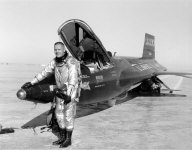
Neil Armstrong, with Michael Collins, and Buzz Aldrin, after visiting the Moon in Apollo 11:
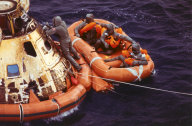
X-15 Test Pilots:
PICT8153.JPG
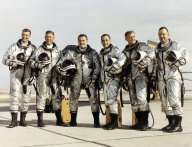
SR-71 over the Sierras, after aerial refueling:
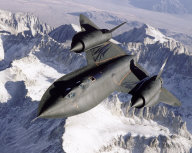
An Analog Computer at the Lewis Flight Propulsion Laboratory, 1949. This computer didn't use zeros and ones.
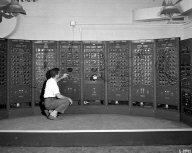
Jupiter's moon Io, by the Galileo spacecraft.
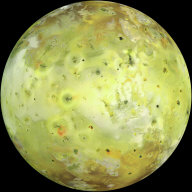
"This mosaic of Europa, the smallest Galilean satellite, was taken by Voyager 2. This face of Europa is centered at about the 300 degree meridian. The bright areas are probably ice deposits, whereas the darkened areas may be the rocky surface or areas with a more patchy distribution of ice. The most unusual features are the systems of long linear structures that cross the surface in various directions. Some of these linear structures are over 1,000 kilometers long and about 2 or 3 kilometers wide. They may be fractures or faults which have disrupted the surface."
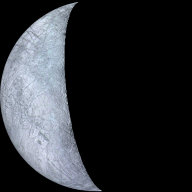
Soviet Sputnik, the first man-made satellite to orbit the earth.
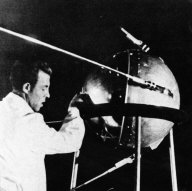
This Soviet 7K-L1 circumlunar spacecraft is on a Proton booster on the way from the assembly building to the launch pad at Tyura-Tam, in the mid to late 1960's. The 7K-L1 was the less-than-successful Soviet counterpart to the U.S. Apollo spacecraft.
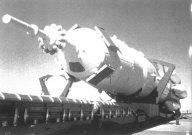
The giant Soviet N1 moon rocket. After take-off the rocket collapsed back onto the pad, destroying the entire pad area in a massive explosion. The rocket in the background is a mockup of the N1 for training.
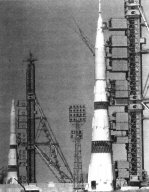
(~) 1955, no rights concerned. Any unauthorized duplication or distribution of this fine piece of work will be met with vigorous and unmitigated apathy. Copy the heck out of it!
If you'd like to sign up for Junkmail, or if you'd like to browse and search previous Junkmails, go to
http://xpda.com/junkmail
If you'd like to stop getting Junkmail, please select any or all of the following:
1. Go to analog computing.
2. Remain disconnected from the internet.
3. Get a new email address and don't tell me what it is.
4. Send me an email with "Kangerlussuaq" as the subject.
5. Click here: http://xpda.com/junkmail/getmeouttahere.asp?off=!*EMAIL*!
I'm Bob Webster from Earth. I can usually be found at bob@xpda.com
Have a nice day!